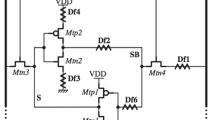Abstract
We present a study on the effects of resistive-bridging defects in the SRAM core-cell, considering different industrial technology nodes: 90 nm, 65 nm and 40 nm. We have performed an extensive number of electrical simulations, varying the resistance value of the defects, the supply voltage, the memory size and the temperature. We identified the worst-case conditions maximizing failure occurrence in presence of defects. Results also show that resistive-bridging defects cause malfunction in the defective core-cell, as well as in non-defective core-cells located in the same row and/or column. Moreover, the weak read fault is the fault that is the most likely to occur due to resistive-bridging defects. Finally, the sensitivity of SRAMs to resistive-bridging defects increases with the advance of technology nodes.













Similar content being viewed by others
References
Adams RD, Cooley ES (1996) Analysis of a deceptive destructive read memory fault model and recommended testing. Proc IEEE North Atlantic Test Workshop
Agarwal K, Nassif S (2006) Statistical analysis of SRAM cell stability. Proc of 43rd Design Automation Conference, pp 57–62
Alves Fonseca R, Dilillo L, Bosio A, Girard P, Pravossoudovitch S, Virazel A, Badereddine N (2010) Detecting NBTI induced failures in SRAM Core-cells. IEEE VLSI Test Symposium, Santa Cruz, USA, Avril, pp 75–80
Bosio A, Dilillo L, Girard P, Pravossoudovitch S, Virazel A (2009) Advanced test methods for SRAMs—effective solutions for dynamic fault detection in nanoscaled technologies, Springer Ed
Cheng B, Roy S, Roy G, Brown A, Asenov A (2006) Impact of random dopant fluctuation on bulk CMOS 6T SRAM scaling. European SolidState Device Research Conference, pp 258261, 19–21 Sept
Dilillo L, Girard P, Pravossoudovitch S, Virazel A, Bastian M (2005) Resistive-open defect injection in SRAM core-cell: analysis and comparison between 0.13 μm and 90 nm technologies. Proc. of 42nd Design Automation Conference, pp 857–862
Dilillo L, Girard P, Pravossoudovitch S, Virazel A, Bastian M (2005) Resistive-open defect influence in SRAM pre-charge circuits: analysis and characterization. Proc IEEE Eur Test Symp, pp 116–121
Dilillo L, Girard P, Pravossoudovitch S, Virazel A, Borri S (2003) Comparison of open and resistive-open defect test conditions in SRAM address decoders. Proc. of IEEE Asian Test Symposium, pp 250–255
Hamdioui S, Al-Ars Z, van de Goor AJ (2002) Testing static and dynamic faults in random access memories. Proc IEEE VLSI Test Symp, pp 395–400
Hamdioui S, Van De Goor AJ (2000) An experimental analysis of spot defects in SRAMs: realistic fault models and tests. Proc IEEE Asian Test Symp, pp 131–138
Huang R, Chou Y, Wu C (2003) Defect oriented fault analysis for SRAM. Proc IEEE Asian Test Symposium, pp 256–261
Majhi AK, Azimane M, Gronthoud G, Lousberg M, Eichenberger S, Bowen F (2005) Memory testing under different stress conditions: an industrial evaluation. Proc Des Autom Test Eur, pp 438–443
Mukhopadhyay S, Mahmoodi-Meimand H, Roy K (2004) Modeling and estimation of failure probability due to parameter variations in nano-scale SRAMs for yield enhancement. Symposium on VLSI Circuits, 2004. Digest of Technical Papers, pp 64–67, 17–19 June
Ney A, Girard P, Landrault C, Pravossoudovitch S, Virazel A, Bastian M (2007) Slow write driver faults in 65 nm SRAM technology: analysis and march test solution. Proc Des Autom Test Eur Conf
Ney A, Girard P, Pravossoudovitch S, Virazel A, Bastian M (2009) Analysis of resistive-open defects in SRAM sense amplifiers. IEEE Trans VLSI Syst 17(10):1556–1559
Rodriquez R et al (2002) Resistance characterization of interconnect weak and strong open defects. IEEE Design & Test of Computers 19(5):18–26
Sachdev M (1997) Open defects in CMOS RAM address decoders. IEEE Des Test Comput 14(2):26−33
Seevinck E, List F, Lohstroh J (1987) Static-noise margin analysis of MOS SRAM Cells. J Solid State Circ 22(5):748–754
Semiconductor Industry Association (SIA) (2009) International Technology Roadmap for Semiconductors (ITRS), http://itrs.net
Tang X, De VK, Meindl JD (1997) Intrinsic MOSFET parameter fluctuations due to random dopant placement. IEEE TransVLSI Syst 5(4):369–376
van de Goor AJ (1998) Testing semiconductor memories, theory and practice. COMTEX Publishing, Gouda
van de Goor AJ, Al-Ars Z (2000) Functional memory faults: a formal notation and a taxonomy. Proc IEEE VLSI Test Symp, pp 281–289
van de Goor AJ, Simonse JE (1999) Defining appropriate SRAM resistive defects and their simulation stimuli. In Proc of Asian Test Symposium, Nov, pp 33–40
Author information
Authors and Affiliations
Corresponding author
Additional information
Responsible Editor: D. Gizopoulos
This work has been funded by the French government under the framework of the CATRENE CT302 “TOETS” European project
This paper is an extended version of a preliminary study published in European Test Symposium 2010, entitled “Analysis of Resistive- Bridging Defects in SRAM Core-Cells: a Comparative Study from 90 nm down to 40 nm Technology Nodes”.
Rights and permissions
About this article
Cite this article
Alves Fonseca, R., Dilillo, L., Bosio, A. et al. Impact of Resistive-Bridging Defects in SRAM at Different Technology Nodes. J Electron Test 28, 317–329 (2012). https://doi.org/10.1007/s10836-012-5291-6
Received:
Accepted:
Published:
Issue Date:
DOI: https://doi.org/10.1007/s10836-012-5291-6




